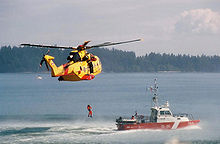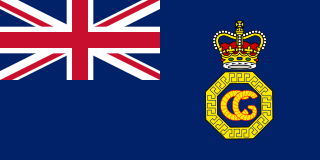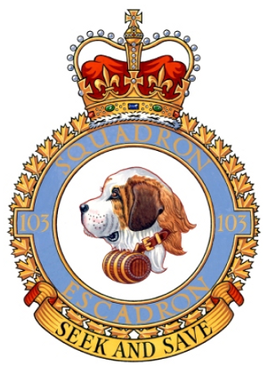Provinces and Territories
In areas of provincial or territorial jurisdiction (e.g. on land or in inland lakes and rivers that are non-federal waters), SAR resources are coordinated by provincial or territorial governments. Response to, and the coordination and supply of resources to, a ground or inland water SAR incident in a province or territory is the responsibility of the provincial or territorial police agency (or a municipal police agency). That police agency, in coordination with the provincial or territorial (or municipal) government, may request federal resources to assist in responding to a ground or inland water SAR incident. This is often in the form of RCAF or CASARA aircraft and occasionally in the form of CCG or CCGA vessels (usually trailer deployed small craft). In the more remote parts of Canada, the Canadian Rangers may be requested to perform search and rescue missions in support of federal and provincial/territorial cases. [11] These requests are coordinated through inter-government agreements.
Commercial air operators, in particular those operating helicopters, are also frequently called upon to assist provincial and territorial authorities with ground and inland water search and rescue missions. Many are certified to Transport Canada standards in the use of Helicopter Flight Rescue Systems (HFRS) or Helicopter External Transport Systems (HETS), and train routinely with the volunteer and Parks Canada specialists who conduct these types of rescue missions.
All provinces and territories have volunteer ground search and rescue (GSAR) organizations that are available to assist the responding police agency by providing trained searchers, equipment, and local knowledge. Some volunteer teams have advanced capabilities in search management and high-angle, swift water, ice, and/or avalanche rescue. Canine teams specialized in search and rescue are also an important component of the GSAR volunteer community. [12] The Search and Rescue Volunteer Association of Canada (SARVAC) is the national body representing ground and inland water SAR volunteers in Canada.
- Alberta
In Alberta, the provincial government agency responsible for coordinating volunteer ground and inland water SAR is the Office of the Fire Commissioner. The RCMP is contracted to provide provincial policing services in Alberta and they, or a municipal police force, are responsible for responding to ground and inland water SAR incidents in the province; however, this responsibility may be delegated to other agencies, namely Kanaskis Country Public Safety section of Alberta Environment and Parks. Volunteer ground search and rescue (GSAR) teams are represented by the SAR Association of Alberta.
- British Columbia
In British Columbia, the provincial government agency responsible for coordinating volunteer ground and inland water SAR is Emergency Management BC. The RCMP is contracted to provide provincial policing services in British Columbia and they, or a municipal police force, are responsible for responding to ground and inland water SAR incidents in the province. Volunteer ground search and rescue (GSAR) teams are represented by the BC Search and Rescue Association.
- Manitoba
In Manitoba, the provincial government agency responsible for coordinating volunteer ground and inland water SAR is the Manitoba Office of the Fire Commissioner. The RCMP is contracted to provide provincial policing services in Manitoba and they, or a municipal police force, are responsible for responding to ground and inland water SAR incidents in the province. Volunteer ground search and rescue (GSAR) teams are represented by Search and Rescue Manitoba.
- Newfoundland and Labrador
In Newfoundland and Labrador, the provincial government agency responsible for coordinating volunteer ground and inland water SAR is Fire and Emergency Services-Newfoundland and Labrador. Policing services in Newfoundland and Labrador are shared between the Royal Newfoundland Constabulary (RNC) in urban areas and the RCMP in rural areas. These police agencies are responsible for responding to ground and inland water SAR incidents in the province. Volunteer ground search and rescue (GSAR) teams are represented by the Newfoundland and Labrador Search and Rescue Association.
- New Brunswick
In New Brunswick, the provincial government agency responsible for coordinating volunteer ground and inland water SAR is the New Brunswick Emergency Measures Organization. The RCMP is contracted to provide provincial policing services in New Brunswick and they, or a municipal police force, are responsible for responding to ground and inland water SAR incidents in the province. Volunteer ground search and rescue (GSAR) teams are represented by the New Brunswick Ground Search and Rescue Association.
- Northwest Territories
In the Northwest Territories, the territorial government agency responsible for coordinating volunteer ground and inland water SAR is the Northwest Territories Emergency Measures Organization. The RCMP is contracted to provide policing services in the Northwest Territories and are responsible for responding to ground and inland water SAR incidents in the territory. Volunteer ground search and rescue (GSAR) teams are represented by the Northwest Territories Search and Rescue Association.
- Nova Scotia
In Nova Scotia, the provincial government agency responsible for coordinating volunteer ground and inland water SAR is the Nova Scotia Emergency Management Office. The RCMP is contracted to provide provincial policing services in Nova Scotia and they, or a municipal police force, are responsible for responding to ground and inland water SAR incidents in the province. Volunteer ground search and rescue (GSAR) teams are represented by the Nova Scotia Ground Search and Rescue Association. [13]
- Nunavut
In Nunavut, the territorial government agency responsible for coordinating volunteer ground and inland water SAR is Nunavut Emergency Management. The RCMP is contracted to provide policing services in Nunavut and are responsible for responding to ground and inland water SAR incidents in the territory. Volunteer ground search and rescue (GSAR) teams are represented by the Nunavut Search and Rescue Association.
- Ontario
In Ontario, the provincial government agency responsible for coordinating volunteer ground and inland water SAR is Emergency Management Ontario. The Ontario Provincial Police (OPP) provides all provincial policing services in Ontario and they, or a municipal police force, are responsible for responding to ground and inland water SAR incidents in the province. Volunteer ground search and rescue (GSAR) teams are represented by the Ontario Search and Rescue Volunteer Association.
- Prince Edward Island
In Prince Edward Island, the provincial government agency responsible for coordinating volunteer ground and inland water SAR is the Prince Edward Island Emergency Measures Organization. The RCMP is contracted to provide provincial policing services in Prince Edward Island and they, or a municipal police force, are responsible for responding to ground and inland water SAR incidents in the province. Volunteer ground search and rescue (GSAR) teams are represented by the Prince Edward Island Ground Search and Rescue Association.
- Quebec
In Quebec, the provincial government agency responsible for coordinating volunteer ground and inland water SAR is the Ministère de la Sécurité publique. The Sûreté du Québec (SQ) provides all provincial policing services in Quebec and they, or a municipal police force, are responsible for responding to ground and inland water SAR incidents in the province. Volunteer ground search and rescue (GSAR) teams are represented by the Association québécoise des bénévoles en recherche et sauvetage.
- Saskatchewan
In Saskatchewan, the provincial government agency responsible for coordinating volunteer ground and inland water SAR is the Saskatchewan Emergency Management Organization. The RCMP is contracted to provide provincial policing services in Saskatchewan and they, or a municipal police force, are responsible for responding to ground and inland water SAR incidents in the province. Volunteer ground search and rescue (GSAR) teams are represented by the Search and Rescue Saskatchewan Association of Volunteers.
- Yukon
In Yukon, the territorial government agency responsible for coordinating volunteer ground and inland water SAR is the Yukon Emergency Measures Organization. The RCMP is contracted to provide policing services in Yukon and are responsible for responding to ground and inland water SAR incidents in the territory. Volunteer ground search and rescue (GSAR) teams are represented by the Yukon Search and Rescue Association.













